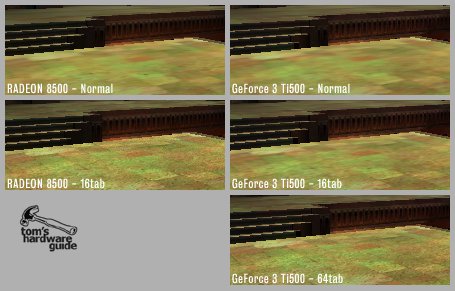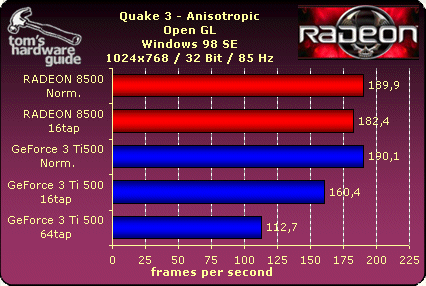RADEON 8500 - Driven To New Heights
Anisotropic Filtering
Anisotropic filtering offers much crisper textures than other methods. Even when using trilinear filtering, the floor textures in Quake 3 appear to be very smudged at a certain range. The much more extravagant anisotropic filtering lessens this effect, though at the cost of speed.
Nvidia and ATi use different philosophies in defining their anisotropic filtering. ATi claims that the Radeon 8500 can do 16tap anisotropic filtering while Nvidia speaks of 64tab of GeForce3. But they mean the same thing - in the end.
ATi's 16 stands for the ratio, or level of filtering employed. Some background information: bilinear filtering requires 4 texels (displayed pixels of a texture, which additionally may already have been manipulated by a light/ pixel shader). Trilinear uses 8 texels, while anisotropic uses 16, 32, 64,128, or more texels. The number in Nvidia's documentation for the Ti500 refers to the number of texels used, e.g. 64tap for 64 texels. On the Radeon, anisotropic filtering uses blocks of already-blended samples [bilinear (4) or trilinear (8)]. Therefore, the highest quality setting on the Radeon 8500 is 16:1 bilinear (64tap). This means that the filter uses 16 blocks of bilinear-filtered texels (16 blocks x 4 texels = 64). Until recently, the ATi drivers had the settings 'High' (4:1 / 16tap), and 'Highest' (16:1 / 64tap).
The quality comparison yields an interesting result: ATi's 16tap is nearly identical to Nvidia's 64tap setting! And that's no Surprise (see text above).
A surprising result! Enabling anisotropic filtering only slows the Radeon down by 7fps. At comparable quality (64tap), the Ti500 loses almost 80fps! Even the relatively moderate 16tap setting costs the Ti500 a full 30fps.
According to ATi, R8500's impressive performance when using anisotropic filtering is the result of a dynamic filter implemented in the driver. This means that the card doesn't necessarily use the highest possible quality filter for a given texture. For example, if you are standing right in front of a wall in a first-person shooter, the driver will only use bilinear filtering (4 texels), since the difference in quality when using anisotropic filtering (64 texels) would be all but unnoticeable (a claim which remains to be proven). In other situations, when looking down a long corridor, for example, the high quality-filter is activated. Since no additional information is available at the moment, here's a quote from ATi's David Nalasco:
"The Radeon 8500 only uses the full number of samples in parts of the image where they are really needed, which saves bandwidth while still delivering full anisotropic image quality - just another example of the 'intelligent architecture' that saves bandwidth whenever possible."
Get Tom's Hardware's best news and in-depth reviews, straight to your inbox.
We're still awaiting a reaction from Nvidia. There is some information that Nvidia is using trilinear anisotropic filtering in GeForce3 compared to bilinear anisotropic filtering in ATI's R8500. Nvidia says that they are using 16 texel samples for triliniar anisotropic filtering, and 8 for bilinear. However, this is hard to estimate because there are no official driver settings yet.

